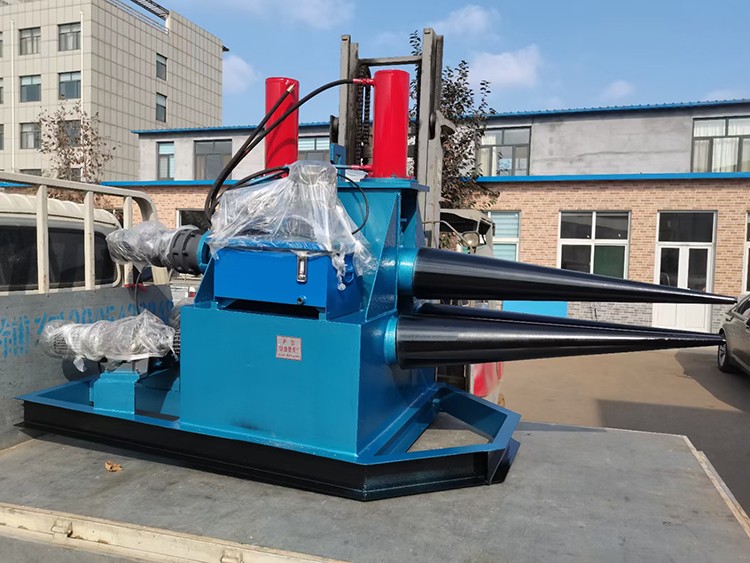

We are a professional manufacturer of rolling cones making machines with over 10 years of industry experience. Today, we would like to introduce a fine-tuning method to enhance the processing accuracy of rolling cones making machines:

Rolling cones making machines are critical equipment used for conical rolling of metal sheets, and their processing precision directly impacts the forming quality of the workpiece. In actual production, factors such as equipment wear, calibration errors, or material springback may lead to issues like conical deviation, seam misalignment, or surface unevenness. By employing reasonable fine-tuning methods, processing precision can be effectively improved without replacing the equipment. Below are several practical adjustment strategies.
1. Equipment basic condition check
Before adjustment, ensure that the equipment itself is in a stable condition. Check whether the roller shaft bearings are loose, whether the transmission gears are worn, and whether the hydraulic system pressure is balanced. If obvious wear is found on mechanical parts, they should be replaced or repaired first to avoid adjustment failure due to mechanical clearance. At the same time, confirm that the equipment base is level to avoid affecting processing stability due to foundation settlement or vibration.
2. Roll gap and alignment adjustment
The gap between the upper and lower roll shafts of the roll forming machine directly affects the feeding accuracy of the sheet material. When adjusting, the roll gap should be set appropriately based on the sheet thickness, typically controlled at 1.1 to 1.2 times the sheet thickness. If the gap is too large, the sheet material may slip; if too small, it may cause excessive deformation. After adjustment, use a feeler gauge to inspect the uniformity of the roll gap, ensuring that the deviation at both ends does not exceed 0.05 mm.
The alignment of the roll shaft is equally critical. If the roll shaft is misaligned axially, it will cause asymmetry in the taper. The adjustment method involves measuring the radial runout at both ends of the roll shaft using a dial indicator under no-load conditions, and then adjusting the bearing seat position to ensure consistency. For large-scale roll forming machines, a laser alignment instrument can be used to enhance calibration accuracy.
3. Optimization of taper curve control
The taper forming of a roll forming machine depends on the coordination of the roll shaft's inclination angle and feed speed. If the workpiece taper does not meet specifications, the inclination of the upper roll or the lifting height of the lower roll can be fine-tuned. When making adjustments, it is recommended to use the trial rolling method: first take a small section of sheet metal for trial processing, measure the taper angle, and gradually make corrections until the requirements are met. For CNC rolling machines, the roll shaft displacement parameters can be fine-tuned in the program to improve repeatability accuracy.
4. Sheet feeding and springback compensation
Metal sheets may experience changes in taper due to elastic springback after rolling. To reduce the impact of springback, the following measures can be taken:
Over-rolling method: Before reaching the target taper, slightly increase the roller pressure or extend the holding time to allow for more complete plastic deformation of the material.
Segmented adjustment: For long conical workpieces, the roll axis angle can be adjusted in multiple segments to avoid excessive local deformation caused by uneven material stress.
Pre-bending treatment: Before formal rolling, the two ends of the plate are pre-bent to reduce springback during subsequent forming.
5. Fine-tuning of processing parameters
The speed, pressure, and other parameters of the roll forming machine must be adjusted according to the material properties. For thicker sheets or high-strength steel, the feed rate should be reduced to prevent roller slippage or surface damage to the sheet. For materials prone to deformation, such as stainless steel or aluminum alloy, the surface finish of the rollers can be appropriately improved to reduce dimensional deviations caused by friction. CNC models can optimize the acceleration curve by modifying the PLC program, resulting in smoother roller movement.
6. Operating Procedures and Maintenance Recommendations
Regular Lubrication: Roll shaft bearings and guide rails should be regularly lubricated with high-temperature grease to reduce the impact of friction on precision.
Mold Adaptation: Different tapered workpieces should use corresponding guide molds to avoid forming errors caused by mold mismatch.
Real-time Monitoring: During processing, laser rangefinders or dial gauges can be used to monitor workpiece dimensions in real time, and any deviations can be adjusted immediately.
The improvement in the precision of a roll forming machine depends on the fine-tuning and optimization of the system, rather than changes to a single parameter. Through reasonable roll shaft adjustment, springback compensation, and processing parameter optimization, the consistency of workpieces can be significantly improved. At the same time, regular maintenance and standardized operation can extend the service life of the equipment and ensure long-term stable processing precision. If repeated adjustments still fail to meet requirements, it is necessary to check whether the equipment structure is damaged or the control system has faults, and contact professional technicians for repairs if necessary.
If you are interested in the rolling cones making machines, please contact us.
 Address:Room 1202, Detaitang Building, No. 118 Huaguang Road, Zhangdian District, Zibo, Shandong
Address:Room 1202, Detaitang Building, No. 118 Huaguang Road, Zhangdian District, Zibo, Shandong WhatsApp:+8615653328535
WhatsApp:+8615653328535 Wechat: +8615965331535
Wechat: +8615965331535  E-mail:zs@sdsmachinery.com
E-mail:zs@sdsmachinery.com